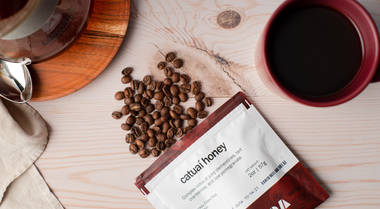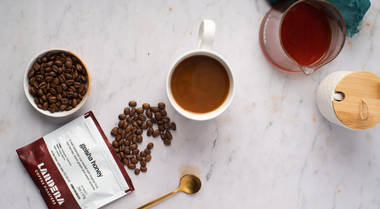The Best Light Roast Coffee Beans
July 07, 2023
by Natasha Nesic

About The Flavor Profile of Coffee
Roasting a coffee bean is necessary because it ensures that certain flavors are released, as well as the specific nutrients and micronutrients— like antioxidants, flavonoids, and polyphenol— that contribute to those flavors.For example, the taste of bitterness or astringency can often be attributed to a chemical-nutritional compound known as “tannin.” These tannins are the same as you hear tossed around in the tea world. This is because you’ll find it’s often placed in the context of green tea, or perhaps another kind of sensitive plant-based drink, that is prone to causing your mouth to pucker in dry humor when the leaves have been over-steeped or mistreated— the reason being that proper green tea steeping of simmering water and no more than 2 or 3 minutes means tannins are less likely to manifest, since the water or cooking method is lower heat and shorter duration.
Now we apply that to coffee, and this is why light roast is many people’s roast of choice.
Just imagine. If a coffee bean is only lightly touched with heat and pressure, then it allows many of the softer, floral-vegetal flavors to stay present since they’re not overpowered by the burning or “cooked” aspect of the roasting process. How delicious is that prospect?
Lardera’s light roasts are nothing to take cracks at, either. (Pardon— that’s coffee humor. When roasting beans, you have to look and listen for what’s called the “first crack.” That will be your indicator that the fruity green beans have started to transmogrify their flavor, and the loss of moisture has led to a very real and literal crack in the bean itself. This is suitable for light roast, and to achieve darker roasts, you will need to wait until you have heard the second crack, or a third crack when you want to go really dark. Beyond that, it’s more like burned toast than tasty roast, and try to spare yourself from that!)
All that being said, here are five reasons why you might call light roast your roast of choice as well.

1. Flavor
The subtleties! The nuances! Using the words “floral” and “vegetal” above means that you have access to all the flavors and accents within those realms. For better examples, a short list of “floral” flavor adjectives may include sensations like: rose, peony, chrysanthemum, marigold, apple blossom, jasmine, carnation, honeysuckle— love this one! — and clover.
Flavor adjectives falling into the “vegetal” category would then be: grass, zucchini, kale, spinach, bok choy, cabbage, bell pepper, carrot, lettuce, radicchio, cauliflower, and broccoli.
Admittedly you might not find a coffee that actually tastes like cauliflower, but it’s still useful to have in mind the possibility that it could have accents of creamy-umami-saltiness that we do often associate with veggies. Great bean examples of these flavors include the Catuai Honey and Tipica Honey for your consideration.
2. Texture
Light roast coffee can go either way— acidic or smooth — and it’s totally up to you how you want to cultivate that in your drinking experience. Longer brewing times with hotter water will provoke the acidic nature to appear — yep, just like in the previous tea example! — and vice versa, shorter brewing times with less intensely heated water will yield a smoother cup.If you’re concerned about this, then we would highly suggest picking up an expert temperature-controlling device like the Smart Electric Kettle, to ensure that you know exactly what temperature you’ll be treating your beans and how that will affect them.
3. Culture
When was the last time you really got to know your coffee, inside and out of the berry? Light roast coffee offers an in-depth glance at the region where the beans were grown, allowing you to taste the experience of the climate and weather with the way the flavors meld themselves into the cup.To get the most out of the subtleties that point to things like weather patterns and growing environment, think about investing in a setup like the Wilfa Performance Coffeemaker that lets you simply sip and savor while taking care of the guesswork in the brewing process.
4. Creativity
The lightness and brightness of this roast has the potential to wake up your brain, due in no small part to the antioxidant profile. Once you’ve mastered the experience with the Smart Kettle and Performance Coffeemaker above, you may want to get a little mad-sciencey and try out different grinds, temperatures, and brewing methods to feel how each change creates a new and interesting kind of cup.Compare and contrast the Wilfa Uniform Grinder with the Chestnut Grinder, for instance. (And along the way, realize that you’ll never go back to instant coffee with how good you can make it on your own!)
5. Convenience
Light roast coffee is widely available on Lardera, and if you decide to try some fresh green beans like the Geisha Caturra Washed yourself, you’ll have the pleasure of a quick, simple roast where you can control the exact lightness of being—or rather, bean.Just don’t forget to keep your coffee in an adequate storage unit like the Lardera Cold Brew Pitcher to make sure that it stays as fresh and fierce as you are!
